Due to ageing populations, governments in most developed countries are seeking to increase the proportion of the population in work (1). Many countries are developing policies to encourage older workers to remain longer in the labor market and non-employed persons to enter paid employment. Entering or leaving paid employment are major social transitions believed to have important consequences for health (2–4).
The health consequences of exiting the labor force might differ between pathways. In general, involuntary routes, most notably unemployment, have adverse effects on mental and physical health, such as depression and anxiety (5), hypertension, arthritis or diabetes (6, 7), and may lead to higher mortality (8, 9) among unemployed persons (10, 11). While contradictory findings have been reported for voluntary routes. A recent systematic review of longitudinal studies found contradictory evidence regarding the effects of early retirement on perceived general and physical health (3). An association between early retirement and increased mortality risk has been reported (12, 13), but the assumed negative health effect of labor force exit may be attributable to health selection rather than causation (14, 15). Individuals who are ineligible for early retirement schemes may also become unemployed or economically inactive. An earlier analysis of the European Community Household Panel (ECHP) – a longitudinal survey in 14 countries with 8 annual waves running from 1994 to 2001 – showed that poor self-rated health was indeed a risk factor for labor force exit due to unemployment, early retirement, or economic inactivity (16).
Disentangling the selection and causation effects is difficult in observational studies. In addition, as the prevalence of poor health increases with age, distinguishing the health effects of labor force exit from those of age is also a challenge. Fortunately, recent developments in longitudinal modelling provide an opportunity to overcome this problem if multiple repeated measurements of health both before and after employment transitions are available (17, 18). Longitudinal health trajectories that change at the moment of leaving or entering employment would support a link between an employment transition and health, whereas stable health trajectories that continue without such a change around or after the employment transition would suggest that such a link is unlikely. A study of Westerlund et al (19) among employees of a French national gas and electricity company showed that retirement was associated with a substantial improvement in self-rated health, since the prevalence of suboptimum self-rated health increased at a significantly faster rate before than after retirement. While health trajectory analyses showed that retirement might be beneficial for self-rated health, this effect was not observed for chronic somatic diseases (20, 21), whereas findings of register-based studies assessing trajectories of antidepressant prescriptions have been inconsistent (22, 23). These intriguing results need to be ascertained for all pathways out of the labor force in different countries.
A recent review showed that entering paid employment was associated with an improvement in health, particularly for depression and general mental health (4). A longitudinal study among unemployed persons in the Netherlands showed an improvement in mental as well as physical health among persons who entered paid employment (24). However, this health improvement may be caused by employment or be the result of an important step in the process of getting back in the labor market. Studying health trajectories before and after entering paid employment can disentangle the causation and selection mechanisms.
Health consequences of entering or leaving employment may also differ between different social groups. An American longitudinal cohort study among employed persons, showed that persons with higher levels of education experienced fewer depressive symptoms after involuntary job loss compared to persons with lower levels of education (25). In contrast, the Whitehall II cohort study of British civil servants found that mental health deteriorated after retiring due to ill-health from a high socioeconomic status (SES) job but not after retiring due to ill-health from a low SES job (14). These studies show that health consequences of employment transitions are complex and non-uniform, which calls for an analysis that separates important socioeconomic groups and takes into account different routes out of the labor market.
In this prospective study, we used yearly measurements of self-rated health from the ECHP to establish how self-rated health is affected by entering or leaving paid employment. The first aim was to investigate the influence of entering or leaving paid employment on self-rated health trajectories before, during and after this transition. The second aim was to investigate educational differences in these self-rated health trajectories.
Methods
Study population
The study population consisted of participants of the ECHP. Data were collected by National Institutes for Statistics or research centers, while the Statistical Office of the European Communities (Eurostat) centrally handled data checks, weightings, and imputations. All surveys were based on non-stratified random sampling among all national private households. All members of the household were individually interviewed. A detailed description of sampling procedures and responses has been published elsewhere (16, 26). The household response rates in the first wave of the ECHP varied between 0.477 (Germany) and 0.844 (Belgium). The household response rates in the following waves were between 0.767 (Denmark) and 0.968 (Portugal) (26).
For the purpose of this study, subjects aged between 18 (minimum at baseline) and 64 (maximum at follow-up) years were selected with available information on employment status and self-rated health status during at least three consecutive annual measurements. Persons who were in military service or following education were excluded from the study. Persons were included in the study once their education was finished. In the youngest age group (18–24 years), low-educated persons were over-represented, because intermediate and high educated persons were in education for more years. In total, 136 556 participants were included in the study.
Labor force participation
Employment status
Employment status was ascertained annually and classified into four mutually exclusive categories: employment (paid employment, paid apprenticeship or self-employment), unemployment, retirement, or economic inactivity. Employment was defined as working in a job for ≥15 hours/week. Subjects working <15 hours per week were classified into the categories unemployment, early retirement or economic inactivity based on their self-reported main activity status. Some of the participants received benefits due to a handicap or disability. A small minority of the early retired (N=146, 3.0%), economically inactive (N=154, 1.6%), and unemployed (N=76, 0.6%) persons received benefits due to a handicap or illness. However, based on the provided information it was not possible to distinguish between work-related disability and other health-related benefits.
Employment transitions
To study self-rated health trajectories before and after employment transitions, time-windows of ≥3 consecutive years were selected. At any time during the complete study period of 8 years, an employed person could leave paid employment due to unemployment, early retirement, or economic inactivity. All yearly measurements in which a person was employed up to the last measurement before labor force exit were included as observations before the employment transition. All yearly measurements in which a person was non-employed from the first measurement after labor force exit were included as observations after the employment transition. The same procedure was followed for employment transitions into the labor force, including all measurements in which a person was non-employed before the employment transition and all measurements in which a person was employed after the employment transition. A person could have multiple employment transitions during the study period of 8 years, all of which were included in the analyses. The number of observations before and after an employment transition varied between 1–7.
Health
One measure of self-rated health was used. Subjects were asked to rate their own general health on a 5-point scale, ranging from “very good”, “good”, “fair”, and “bad” to “very bad”. Those reporting less than “good health” were defined as having a poor self-rated health (27). Information about self-rated health in the years before and after the employment transition was available with a maximum of 7 years before and 7 years after the employment transitions.
Sociodemographics
Individual characteristics included age, sex, and education. Subjects were divided into three groups according to their level of educational attainment on the basis of the International Standard Classification of Education. A high education was defined as higher vocational training or university (ISCED 5-7), intermediate education was defined as higher secondary education and intermediate vocational training (ISCED 3-4), and low education was defined as lower secondary education, primary and pre-primary education (ISCED 0-2) (28).
Country
The European countries were categorized into four different regions, based on geography and welfare state regime (29). The Nordic (Social Democratic) and Continental (Bismarckian) regions were characterized by a rather generous welfare system with high benefits, whereas the Anglo-Saxon (Liberal) and Southern region (Traditionalist) typically had a less generous welfare system with low benefits. The Anglo-Saxon region included the United Kingdom and Ireland. The Continental region included Germany, France, Belgium, Austria, Luxembourg, and the Netherlands. The Nordic region included Denmark, Finland, and Sweden. The Southern region included Spain, Greece, Italy, and Portugal.
Statistical analysis
Logistic regression analysis was used to investigate demographic and health determinants of re-employment and labor force exit due to unemployment, economic inactivity, and early retirement. For the analysis of determinants of early retirement, only subjects in the age groups 45–55 and 55–64 years were used, as occurrence of retirement among those aged <44 years was almost absent.
To examine changes in self-rated health, a repeated-measures logistic regression analysis was used by the generalized estimating equations method. This method takes into account the intra-individual correlation between measurements and is not sensitive to missing measurements. All analyses were adjusted for sex, age, educational level and European region.
With the following regression model, the trend of self-rated health before the employment transition and the changes in level and trend after the employment transition were estimated:
Yt = β0 + β1 × time t + β2 × employment transition t + β3 × time after employment transition t + et
Here Yt is the self-rated health (poor or good) of a person at time t; time is a continuous variable indicating time in years from the start of the observation period; employment transition is an indicator for time t occurring before (employment transition=0) or after (employment transition=1) the transition; and time after employment transition is a continuous variable counting the number of years after the employment transition at time t, with reference 0 for all years before the employment transition. In this model, β0 estimates the baseline level of self-rated health at time zero; β1 estimates the change in self-rated health per year before the employment transition (ie, the baseline trend); β2 estimates the change in self-rated health in the year of the employment transition; and β3 estimates the change in the trend of self-rated health after the employment transition compared to the trend before the employment transition. The sum of β1 and β3 is the trend after the employment transition. The error term (et) at time t represents the random variability not explained by the model (17).
The β were transformed in odds ratios (OR) that represent the yearly increase or decrease in the likelihood of poor self-rated health. The effect of educational level on the shape of the trajectory of self-rated health before, during, and after the employment transition was investigated by entering the interaction terms education with β1, education with β2, and education with β3 in the regression model, adjusted for age and sex and European region.
A sensitivity analysis was done to investigate whether exclusion of persons receiving benefits due to a handicap or illness after labor force exit influenced the results of the study. Stratified analyses were done for males and females and for different European regions. All analyses were carried out with the statistical package SPSS, version 21 (IBM, Armonk, NY, USA).
Results
The study population consisted of 136 556 persons who participated in the ECHP with in total 714 292 observations in the years before and after 198 808 employment transitions. During the 8-year follow-up period, employed persons left paid employment due to unemployment (11 949 transitions), early retirement (4769 transitions), economic inactivity (9573 transitions), or continued to be employed (96 922 transitions). Non-employed persons entered paid employment (25 049 transitions) or continued to be non-employed (50 546 transitions). The mean number of observations before and after an employment transition varied between 2.00–4.82 and 1.99–2.76, respectively, for different pathways (table 1).
Table 1
Number of persons, transitions, observations, and mean number of observations before and after employment transitions (ET) into and out of the labor force.
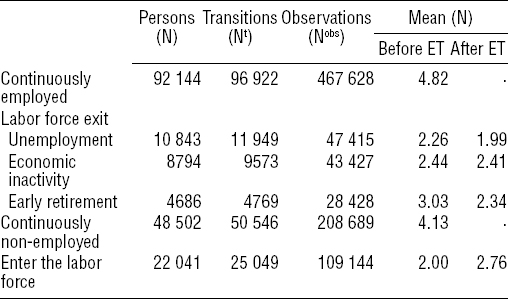
Table 2 shows that exit from paid employment was more prevalent among low-educated, female, older workers, those with a poor self-rated health, and individuals living in the Southern European region. Entering paid employment was more prevalent among male, young, high educated persons, and those with a good self-rated health and less prevalent among individuals from the Continental European region.
Table 2
Individual characteristics, self-rated health, and European region of the participants who were employed or unemployed at baseline and (partly) had an employment transition into or out of the workforce at follow-up. [LF=labor force]
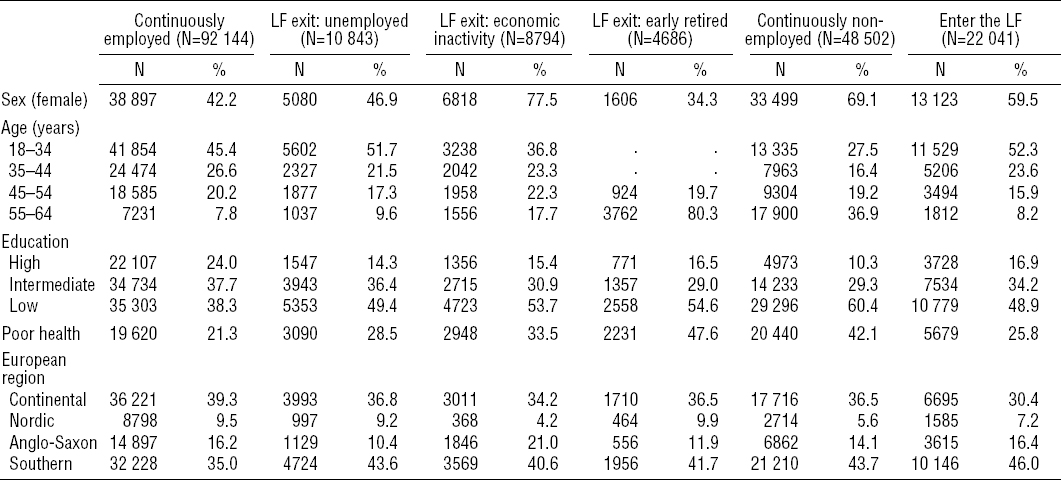
Table 3 shows that persons with a poor self-rated health were more likely to leave paid employment due to unemployment [OR 1.44, 95% confidence interval (95% CI) 1.38–1.51], economic inactivity (OR 1.42, 95% CI 1.35–1.49), and early retirement (OR 1.48, 95% CI 1.39–1.59) and less likely to enter paid employment (OR 0.72, 95% CI 0.70–0.75). Females and low educated workers were more likely to leave the labor force through all different pathways, except for early retirement, and were less likely to enter paid employment. Younger persons were more likely to leave the labor force through unemployment, whereas older persons were more likely to leave the labor force through economic inactivity or early retirement and less likely to enter paid employment.
Table 3
Determinants of employment transitions into or out of the workforce due to unemployment, economic inactivity, and early retirement (logistic regression analyses). [OR=odds ratio; NT=number of employment transitions; 95% CI=95% confidence interval.]
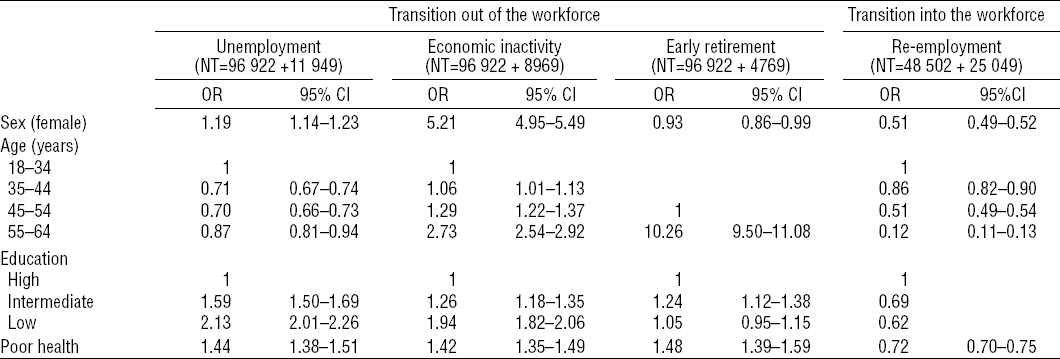
Figure 1 shows that the annual increase in prevalence of poor self-rated health before early retirement almost completely levelled off in the years after early retirement. A steep increase of poor self-rated health was found in the first years after unemployment. An increase in the prevalence of poor self-rated health was also found during the transition into economic inactivity, which was attenuated in the first years after becoming economically inactive. In the years before entering paid employment, an annual decrease in the prevalence of poor self-rated health was found.
Figure 1
Prevalence of poor self-rated health in the years before and after employment transitions into and out of the workforce due to unemployment, early retirement, or economic inactivity.
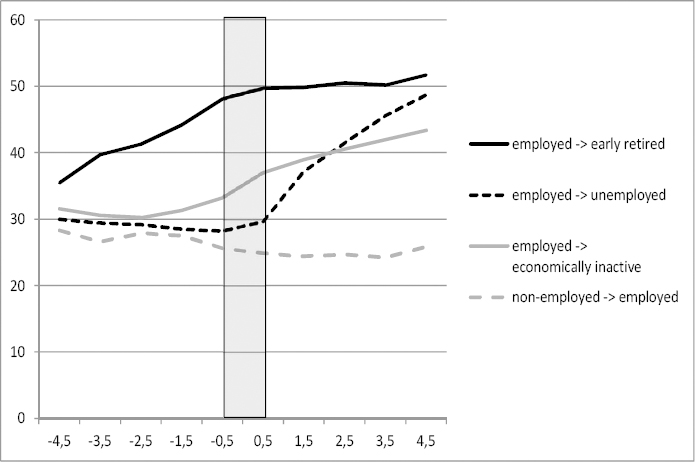
Table 4 shows that individuals who became early retired or economically inactive experienced an increase in poor self-rated health in the years before (OR 1.11 and 1.05, respectively) and at the year of exit paid employment (OR 1.08 and 1.18, respectively), but in the years after retirement there was no significant change in self-rated health status (OR 1.00 and 1.01, respectively). Unemployment had a negative influence on self-rated health, which was shown by a yearly increase in the likelihood of poor self-rated health (OR 1.06) after becoming unemployed. In the year of entering paid employment the likelihood of poor self-rated health decreased (OR 0.93).
Table 4
Trajectories in poor self-rated health before, during, and after employment transitions through different pathways. [Adjusted for sex, age, educational level and European region; ET=employment transition; OR=odds ratio: change in the likelihood of poor health per year; 95% CI=95% confidence interval.]
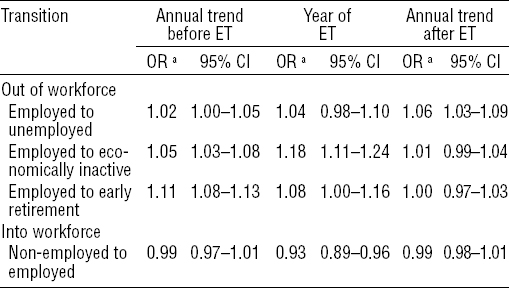
A sensitivity analysis showed that becoming economically inactive was much more prevalent among women than men, but only among men those economically inactive experienced an increase in poor self-rated health in the years before (OR 1.09, 95% CI 1.05–1.14), during (OR 1.32, 95% CI 1.06–1.20), and after (OR 1.11, 95% CI 1.05–1.18) labor force exit. In addition, unemployment had a more profound negative influence on self-rated health among men (OR 1.13, 95% CI 1.08–1.18) than among women (OR 1.01, 95% CI 0.97–1.05) (supplemental tables 1 and 2, www.sjweh.fi/data_repository.php). Differences between European regions were found in the association between unemployment and self-rated health. The worsening of self-rated health after labor force exit due to unemployment was more pronounced in the Anglo-Saxon region (OR 1.20, 95%CI 1.07–1.34), compared to the Continental (OR 1.07, 1.04–1.10) and Southern region (OR 1.05, 1.00–1.10), whereas a worsening of self-rated health was not found in the Nordic European region (OR 1.01, 95% CI 0.90–1.15) (supplemental tables 3–6, www.sjweh.fi/data_repository.php).
Table 5 reports the educational differences in trajectories around employment transitions. Among low and intermediate educated workers, the likelihood of poor self-rated health increased during the years before early retirement (OR 1.14 respectively 1.09), but remained stable in the years after early retirement; whereas among high-educated workers, the likelihood of poor self-rated health increased during the years after early retirement (OR 1.10). All educational groups showed an immediate increase of poor self-rated health in the year of becoming economically inactive (OR 1.16–1.21). During the years after unemployment, the likelihood of poor self-rated health increased among all educational groups. However, only among low-educated workers the likelihood of poor self-rated health also increased during the years before unemployment. High- and intermediate-educated persons showed a decrease of poor self-rated health (OR 0.93 and 0.95, respectively) before entering paid employment, whereas low-educated persons showed a decrease of poor self-rated health in the year of the employment transition (OR 0.88) and after entering paid employment (OR 0.98). A sensitivity analysis showed very similar results after exclusion of persons who received benefits due to a handicap or illness out of the study population (data not shown).
Table 5
Educational differences in trajectories in poor self-rated health before, during, and after employment transitions through different pathways. [Adjusted for sex, age, educational level and European region; ET=employment transition; OR=odds ratio: change in the likelihood of poor health per year; 95% CI=95% confidence interval.]
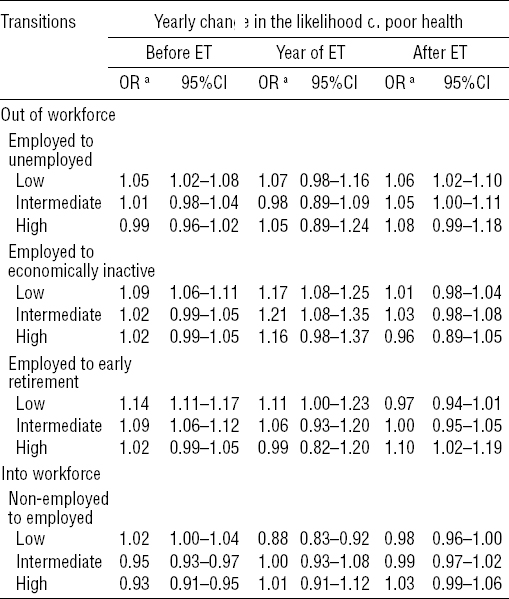
Discussion
Among low-educated workers, ill-health partly prompted their voluntary labor force exit through early retirement and becoming economically inactive, but thereafter these exit routes seemed to prevent further deterioration of their health. In contrast, among higher educated workers, early retirement had an adverse effect on their self-rated health. Becoming unemployed had adverse effects on self-rated health among all educational levels. Entering paid employment was predetermined by self-rated health improvement in the preceding years among intermediate and high educated workers, whereas among low educated workers self-rated health improved in the year of entering paid employed and continued to improve in the following years.
Two other studies (14, 19) corroborate our finding that early retirement stalled the gradual worsening in self-rated health among low and intermediate workers, whereas among highly educated workers early retirement seemed to have an adverse effect. The Whitehall II study of British civil servants showed a recovery from an initially poor physical functioning among participants with low socio-economic status (SES), whereas mental health deteriorated after retiring due to ill health from a high SES job. The authors suggested that having to retire due to ill-health may be mentally more stressful to employees with high SES because they lose a high-status occupation (14). In addition, Westerlund et al, found that French employees in low and intermediate grades had a significantly less favorable self-rated health trajectory before retirement than those in high grades. After retirement this pattern was reversed, and no additional deterioration was seen among employees in low grades (19). These findings could be an indication of the greater work-related health burden before retirement that has been noted among workers in low-grade jobs (30–32). Although we found that early retirement was beneficial for self-rated health, especially among low-educated workers, previous studies have suggested that possible beneficial effects may be limited to self-reported health conditions, such as self-rated health and exhaustion, and may be absent when it comes to diagnosed chronic somatic diseases (20, 21).
It has been postulated that especially for low-educated workers with a compromised health, early retirement may come as a relief (33). However, for many low-educated workers, early retirement may not be feasible. These workers may take another voluntary or involuntary pathway out of the labor force. Among low educated workers who became economically inactive, a similar pattern was found: a gradual increase of poor self-rated health during the years before labor force exit, which was attenuated in the years after becoming economically inactive.
In this study, it was difficult to differentiate between voluntary and involuntary transitions out of employment. For most people, early retirement may be a voluntary transition out of employment, but some people might have been forced into early retirement as an alternative to unemployment with lower benefits. On the other hand, although unemployment usually will be an involuntary transition out of employment, sometimes short periods of unemployment may be chosen as pathway towards retirement. Therefore, in our analysis the pathways out of employment were defined by employment status (unemployed, early retired, economically inactive) after quitting paid employment, rather than distinguishing between voluntary and involuntary pathways out of paid employment.
The finding of the current study that unemployment resulted in a gradually increase of poor self-rated health among all educational groups is in line with the findings of other studies, which have shown that unemployment leads to declines of psychological and physical health (2, 10, 11, 34). A longitudinal study among Swedish workers found an increase of hospitalization in the two years following labor market exit due to unemployment (35). The self-rated health trajectory analysis of the current study shows a change in trend at the moment of involuntary job loss, supporting a causal effect of unemployment on poor self-rated health. However, among low-educated workers, the gradual worsening of self-rated health was already present in the years before entering paid employment, supporting a health selection process of low-educated workers into unemployment. Apparently, selection as well as causation mechanisms play a role in explaining the health differences between unemployed and employed persons.
Differences between European regions were found in the effect of unemployment on self-rated health. Self-rated health worsened after labor force exit due to unemployment in all regions except the Nordic European region. This finding is in accordance with another study on ECHP data from Finland, which concluded that there was no causal effect of unemployment on health in that Nordic country (36). Welfare regimes may influence the effect of unemployment on health. Nordic European countries are characterized by a rather generous welfare system with high benefits, whereas Ireland and the UK typically have a less generous welfare system with low benefits (29). The negative health effects of unemployment were more pronounced in European regions with less generous welfare regimes. This finding was corroborated by a fixed effect model on 15 waves in a US household panel survey, which showed that higher generosity of state unemployment benefits alleviated the adverse health effects of unemployment among men (37).
The current study found an improvement of self-rated health among persons who entered paid employment. This finding corroborates the results of an earlier study among unemployed persons in the Netherlands, which also found an improvement of self-rated health among persons who entered paid employment (24). However, this earlier study had a pre–post design, with one measure before and one measure after entering paid employment, which made it difficult to draw any conclusions on causality. The self-rated health trajectory analysis of the current study gives more insight into the causal relationships between health and employment among different educational groups. Interestingly, there were clear educational differences. Among intermediate- and high-educated workers, the process of recovery from health problems seemed less caused by employment, but rather an important step in the process of getting back in the labor market since health improved steadily before entering paid employment. However, among low educated workers, the step change at the moment of entering paid employment, supports a causal effect of employment on self-rated health.
A major strength of this study is that it is based on repeated yearly measurements over an extended time, covering 14 European countries. The data allowed us to model self-rated health trajectories across the adult life course. When randomized controlled trials are not feasible, a time series design is a strong alternative to estimate the effect of employment transitions on health (38). Interrupted time series data allows analysis to control for prior trends before an employment transition and to study the dynamics of change after an employment transition (17, 39).
The ECHP ran from 1994–2001. There is a danger that our findings might be somewhat outdated. Since then, the legislation regarding retirement schemes and early exit routes and benefits as well as the economic circumstances have changed in many countries. A European comparative study reported that disability and unemployment was consistently lower in welfare state regimes with better protective legislation and supportive measures for workers with longstanding illness (40). A recent study demonstrated that stricter disability criteria in Austria had important spillover effects on unemployment and health (41). During recent years of economic crisis persons with health problems seem to experience larger difficulties to re-enter paid employment (42). The current study showed that the negative health effects of unemployment were more pronounced in European regions with less generous welfare regimes. Hence, there is a clear need to corroborate our findings in different jurisdictions and under different economic circumstances in more recent years.
A disadvantage of the current analysis is the restriction to one measure of self-rated health. However, several studies have shown that self-rated suboptimum health is strongly and consistently associated with all-cause mortality (43, 44) and with mortality and morbidity due to a range of chronic diseases including diabetes, heart disease, stroke and cancer (45–47). It is also strongly predictive for entering and losing paid employment (48, 49) and, hence, a suitable measure of health to study in trajectories over time in the workforce. Subjects were divided in just three groups according to their level of educational attainment. When investigating differences in health trajectories between educational groups, it is important to have not too many educational groups in order to be able to present distinguishable and meaningful trends among the different educational subgroups. In addition, our measure of educational level is usually used in large longitudinal studies (48).
The model we used assumes a linear trend of self-rated health in the period before and after the employment transition. The assumption of linearity often may hold only over short intervals. Changes of self-rated health after an employment transition may follow non-linear patterns. However, the graphical presentation of the change of self-rated health in time (figure 1) depicted linear relationships of health and time in the time-periods before and after the employment transitions. Therefore, based on visual inspection of the data, we feel it is reasonable to accept the assumption of linearity in the current study.
Our study indicates that especially low-educated workers are faced with a gradual worsening of self-rated health before labor force exit due to unemployment, economic inactivity or early retirement. Their early retirement and economic inactivity had a positive influence on health. Improvement of self-rated health can be explained by factors such as removal of work-related mental or physical strain, increased leisure time and opportunity to pursue personal interests and hobbies (14, 50, 51). These mechanisms, however, apply less to high educated workers whereby involuntary job loss as well as early retirement had a negative influence on self-rated health. This gradual deterioration of self-rated health might be explained by factors such as the loss of highly valued work, and negative changes in lifestyle (10).
Policy implications
It is important to be aware of that employment transitions have different health effects for different groups of workers. Among low-educated workers, ill-health partly prompted their voluntary labor force exit through early retirement and becoming economically inactive, but thereafter these exit routes seemed to prevent further deterioration of their self-rated health. In contrast, among higher educated workers, early retirement had an adverse effect on their self-rated health. These findings suggest that prolonging working life may have both adverse and beneficial effects on health, also depending on the educational level of individuals. National policies to increase labor force participation at older age should prevent unemployment because it is seems to be health-hazardous for employees of all educational levels. When increasing the statutory retirement age, it is important to open possibilities for early retirement for employees of low-educational level. Based on the findings of this study, health inequalities may increase when every person, independent of educational level, is required to perform paid employment until the same age before being able to retire.



